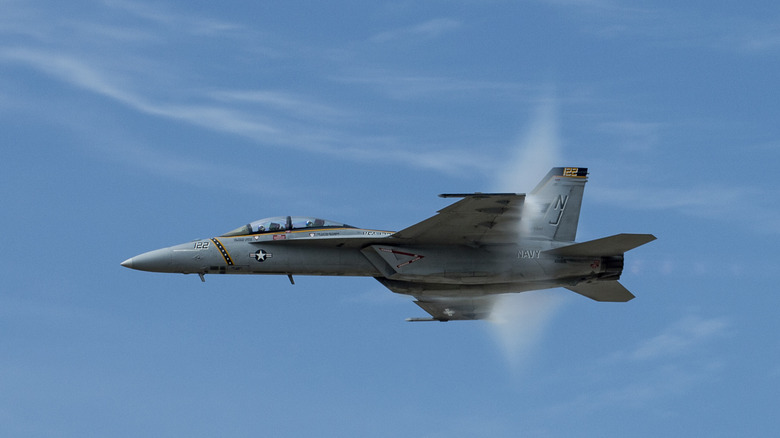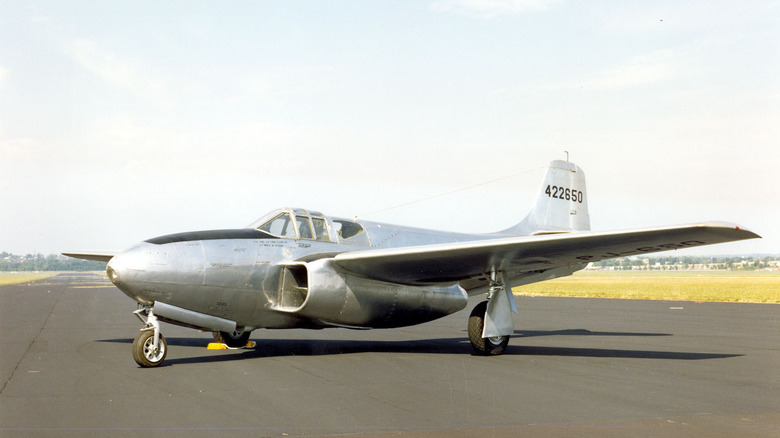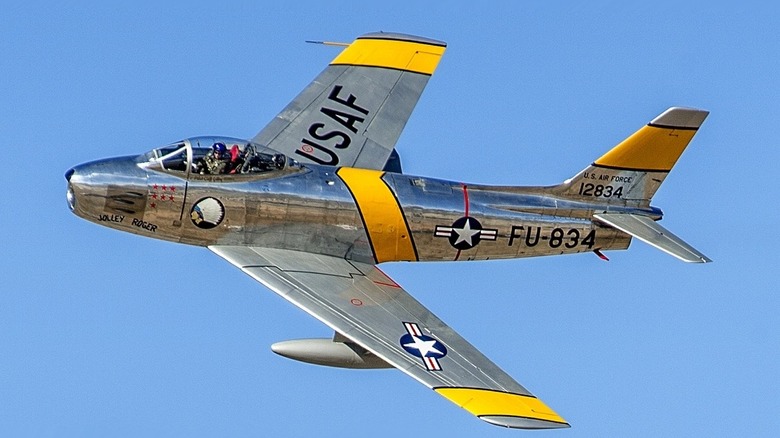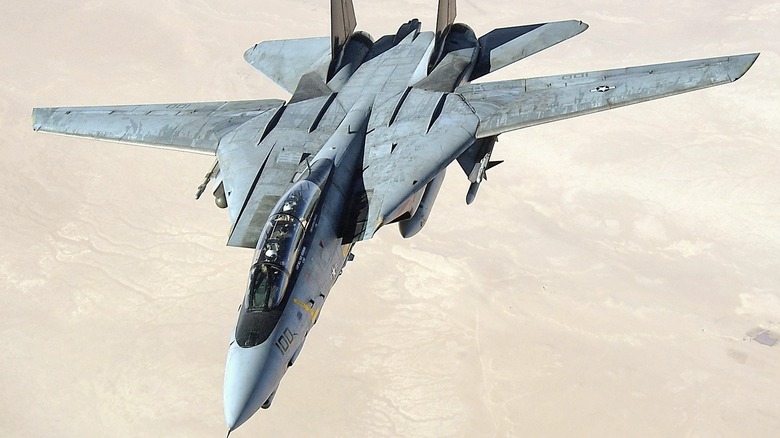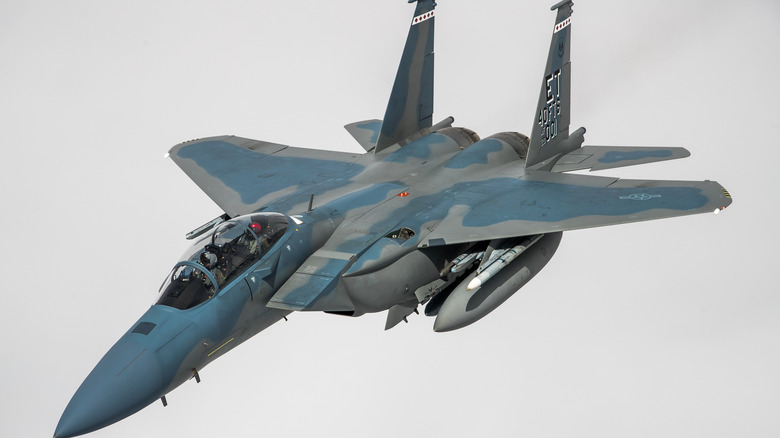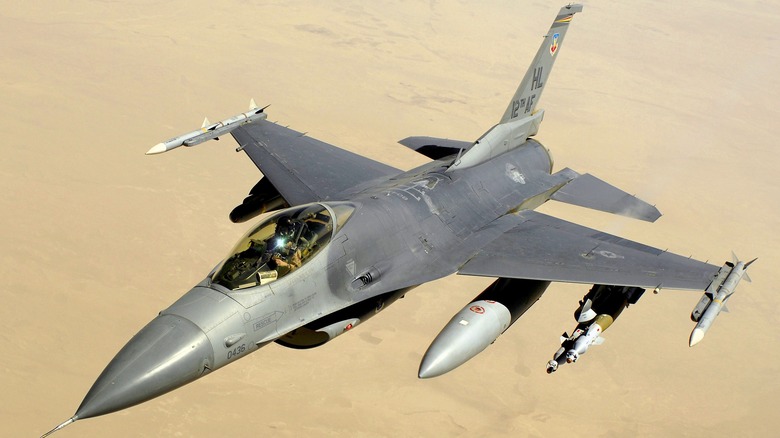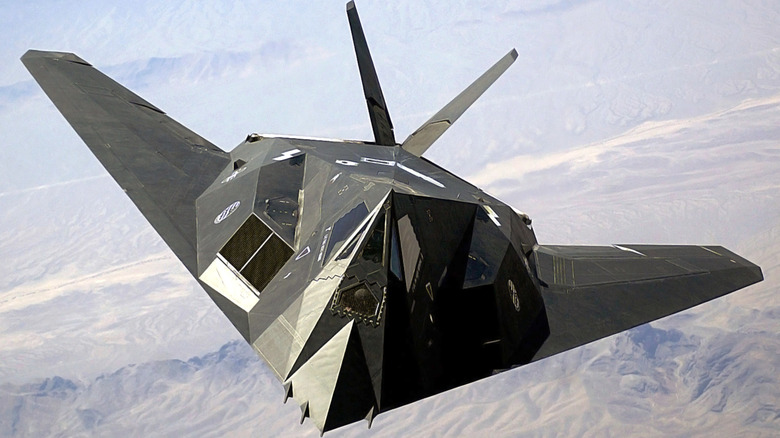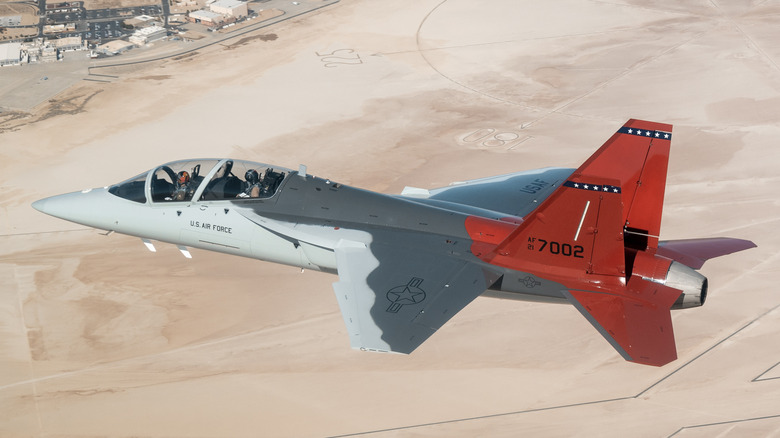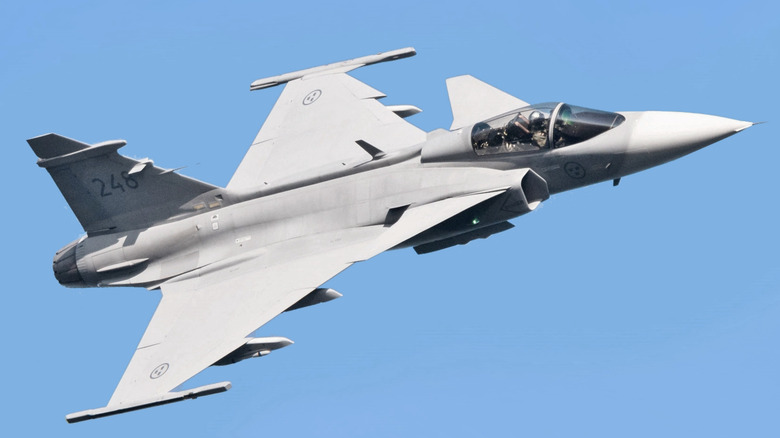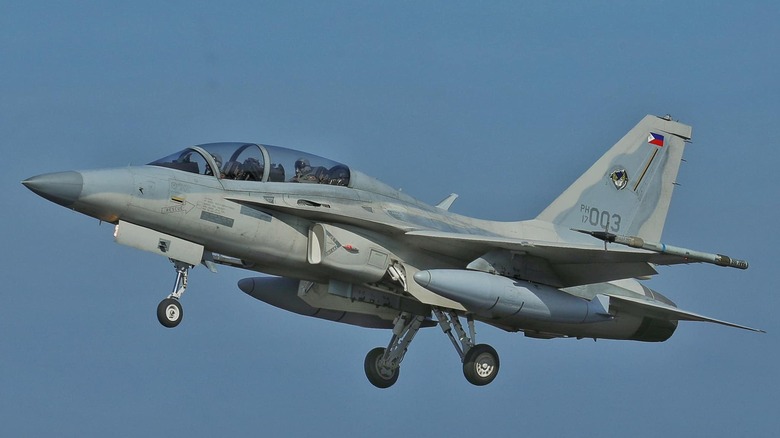10 Fighter Jets With GE Engines
The General Electric Company's jet engine division, now known as GE Aerospace, has been at the center of engine development for jet fighters from the very beginning. During World War II, the U.S. Army Air Corps (the predecessor of the U.S. Air Force) sought to build a version of a jet engine developed in Britain by Sir Frank Whittle. Because of GE's expertise in building turbosupercharged engines for propeller-driven military aircraft, the Air Corps chose GE to build America's first jet engine at its factory in Lynn, Massachusetts. This engine was called the I-A, and later the J33, establishing GE's prominence at the earliest dawn of the Jet Age.
Later years saw a rough stretch for GE's military engine program. By the early 1980s, only Pratt & Whitney supplied engines for Air Force fighter jet contracts. The Air Force wanted a competition between manufacturers, leading GE Aerospace to develop its F101 engine from the B1 Lancer bomber into a fighter jet engine. The resulting engine, called the F110, debuted in 1984 as GE's entrant into the Great Engine War of the 1980s. The F110 would go on to power some of the most iconic fighters of the past four decades, as we'll see in the list below.
Of course, a full list of General Electric jet engines encompasses much more than fighter jets, including engines for bombers like the B-1 and commercial aircraft. But jet fighters thrill the imagination and test the limits of aviation technology. What follows is a list of 10 fighters equipped with GE engines from World War II through today.
Bell P-59 Airacomet
We've already encountered the story of the I-A engine (a.k.a. the J33), and this is where the story of the first U.S. jet fighter in history begins. The Axis and the Allies were rushing to gain an edge in the brutal warfare in the skies above Europe. The British had developed the Power Jets W-1, the engine developed by Sir Frank Whittle, and an American general had seen one during a visit to Britain in 1941. The U.S. Army Air Corps sought to build an engine based on the Whittle design, leading to the GE I-A engine.
Bell Aircraft was chosen to build a fighter around the new engine. Bell had built aircraft like the P-39 Airacobra, and the P-63 Kingcobra, which largely served in an export role in the Soviet Union's war against Nazi Germany on the Eastern Front. The Airacomet, however, was intended for service with the U.S. Army Air Corps in a race to beat the Germans. The Army initially ordered 100 to be built. In the Airacomet type B, two GE J-31 engines produced 1,650 pounds of thrust each, good for a maximum speed of 450 mph, a ceiling just under 44,000 feet, and a maximum range of 525 miles. The P-59B fielded three .50-caliber machine guns and one 37 mm cannon for armaments.
The Airacomet first flew in October of 1942. Unfortunately, jet aviation was in its infancy, and the prototype P-59's engines proved to be unreliable. Its maximum airspeed was actually lower than that of the propeller-driven P-51 Mustang. The Airacomet never served in combat, and only about half of the original order of 100 was ever built. Instead of the Airacomet, the German Messerschmitt Me 262 became the world's first combat jet fighter.
North American F-86 Sabre
The early, tense years of the Cold War spurred some of the most rapid development of military systems in history. In aviation, this led to a quick transition from piston-engine aircraft to jet-powered fighters and bombers. One of the most successful machines of the early Jet Age was the F-86 Sabre, the United States' first swept-wing fighter jet. In the Korean War, the F-86 was credited with a victory ratio as high as 6 to 1. The engine that powered this knight of the sky was the General Electric J47.
The J47 arose from an initiative spearheaded by GE beginning in 1946. The engine utilized innovative compressor and turbine sections and lightweight components to generate 5,000 pounds of thrust — an enormous increase over the 1,250 pounds of thrust created by the I-A/J33 engine from just a few years prior. It also incorporated an anti-icing system to prevent icing issues at high altitudes, along with the world's first electronically-controlled afterburner. In various iterations of the F-86, the J47 achieved one world speed record after another until the F-86D reached 715 mph in 1953.
The Sabre entered combat above Korea in December of 1950, instantly shattering the dominance of Soviet-built MiG-15s. In short order, the F-86 Sabre ruled the skies in Korea, shooting down as many as 800 MiG-15s by the war's end. Its power, maneuverability, and fearsome arsenal of guns proved too much for its enemies.
Grumman F-14B Tomcat
The F-14 Tomcat, the legendary Top Gun fighter, had a troubled early history due to its original engines: a pair of Pratt & Whitney TF30s. The U.S. Navy solved the problem by switching to the General Electric F110-GE-400. The original TF30 engines offered 20,900 pounds of thrust, or 30,000 with the afterburners ignited, and they provided the Tomcat with excellent range, too. However, they were prone to compressor stalls at high angles of attack or when afterburners were ignited. As a result, the Tomcat couldn't take advantage of the full performance envelope that its variable-sweep wings should have provided. Plus, with the engines mounted nine feet apart, if one engine stalled, the other would push the F-14 into an often-fatal flat spin.
Beginning with the F-14B and continuing with the F-14D, the Navy switched to the F110-GE-400 engines, which mitigated these issues. Thrust was similar at 28,200 pounds with afterburners, but the engines were more reliable. Although budget restrictions made the changeover to the GE engines a slow process, by 2004, the Navy's F-14 fleet was primarily powered by F110 engines. Unfortunately, it was still an expensive and difficult plane to maintain, and in 2006, the U.S. Navy retired the F-14 Tomcat in favor of the F-18 Hornet.
Boeing F-15 / F-15EX Eagle
GE's F110 engines had seen service in F-15 variants flying in foreign air forces as long ago as 2005, when it debuted in South Korea's F-15K. In that plane, the F110-GE-129 generates 29,000 pounds of thrust to power its air superiority fighter role. Sixteen years later, the same engine was chosen to power the F-15EX Eagle II for the U.S. Air Force. This was the culmination of a program that GE Aerospace undertook in 2014, allowing it to fully integrate the engine with the F-15EX's fly-by-wire technology. The extra thrust offered by the plane's twin GE engines helps to make the F-15EX Eagle II the U.S. Air Force's missile truck.
The new variant of the Eagle gained this nickname because of the huge number and variety of missiles it can carry. It can be fitted with up to six AIM-9X Sidewinders or twelve AMRAAMS for air-to-air interdiction missions. It can also carry 16 Stormbreaker smart weapons. Alternatively, it can carry 24 air-to-ground munitions. Combined with a six-barrel 20 mm cannon, the Eagle II absolutely bristles with up to 29,500 pounds of weaponry controlled by an ultra-sophisticated avionics suite. This includes AESA radar, a touchscreen interface, and a Joint Helmet-Mounted Cueing System (JHMCS). This effectively turns an airframe that first flew in 1972 into a brand-new 21st-century fighter.
Lockheed Martin F-16 Fighting Falcon
As the F-16 fighter jet has evolved over its five-decade history, the Fighting Falcon has used engines from two manufacturers, with one of the engines being the GE F110. The F-16 was conceived in the 1970s as a lightweight, single-engine, multi-role fighter capable of carrying out missions ranging from air-to-air combat to nuclear weapons delivery. Multiple blocks of F-16 production have featured GE F110 engines. Block 30 models sported an F110-GE-100, while Block 50's thrust came from an F110-GE-129. Both variants produced 29,000 pounds of thrust, giving this small and agile fighter tremendous performance, including speeds exceeding Mach 2. Block 60 increased thrust even further to 32,500 pounds via an F110-GE-132. Other blocks used Pratt & Whitney engines.
Since the 1980s, the F-16 fighter has evolved with advanced radar and systems enabling all-weather operation. Compatible targeting systems expanded to include Sniper Advanced Targeting Pod and the LANTIRN infrared targeting system. It also carries the Legion-ES Infrared Search and Track sensor suite, while weapon capabilities evolved to include the AIM-120 AMRAAM missile. Though the F-16 has competition from the F-35 in U.S. service, it remains relevant, with the new Block 70/72 variant introducing significant upgrades such as a new center pedestal display and APG-83 AESA radar. Currently, more than two dozen countries operate F-16 variants, with Ukraine being the most recent addition to this roster.
Boeing F/A-18E and F/A-18F Super Hornet
The U.S. Navy's famously versatile carrier-based fighter-attack jet, the F/A-18 Super Hornet, is powered by a pair of GE F414-GE-400 engines. This powerplant is the successor to the F404-GE-400 found in earlier generations of the Hornet before it became the Super Hornet. The new engine gives the Super Hornet 35% more thrust than its predecessor while improving the aircraft's performance, survivability, and payload capacity. Modular design ensures reliability and easy maintenance, while advanced materials and cooling techniques extend the life of engine components. With 22,000 pounds of thrust in each of its two F414 engines, the Super Hornet can perform its multi-role duties with greater speed, range, and maneuverability than its Hornet predecessor.
The new F/A-18 Block III Super Hornet delivers even greater power and capability. Engine refinements provide up to 20 percent more thrust, while advanced cooling systems and improved fuel efficiency provide greater range and edge-of-the-envelope performance. Even as the world moves more toward stealth aircraft like the F-35C, which will eventually take a leading role aboard U.S. Navy carriers, the F/A-18 Super Hornet remains arguably the most powerful carrier-based aircraft currently in operation.
Lockheed-Martin F-117 Nighthawk
The F-117 Nighthawk, America's invisible stealth jet, heralded a new age of combat in the skies during the Persian Gulf War in 1991. Unseen by Iraqi radar, it reportedly flew more than 1,200 combat missions without a scratch. While its stealth technology eventually became outdated and the Nighthawk was retired, it's still flying as a designated stealthy opponent in training programs. Through it all, it's been powered by twin GE F404 engines. This family of engines generates between 17,700 and 19,000 pounds of thrust. In the F-117, the F404 engine lacked an afterburner as the Nighthawk was designed only for high subsonic speeds, relying on stealth rather than speed to catch opponents off guard.
The F-117's angular appearance and jet-black, radar-absorbing paint give it an appearance unique in aviation history. As the first stealth combat aircraft, it suffered from a number of compromises made necessary by its first-generation stealth protocols. We've already mentioned that it was subsonic in an age of supersonic jets. Furthermore, its angled surfaces broke up incoming radar waves, but this also made the plane inherently unstable. Without its advanced avionics and fly-by-wire controls, it would have been difficult or impossible to fly. This gained it the nickname Wobblin' Goblin. Nevertheless, its status as the world's first stealth fighter has cemented its place in aviation history.
Boeing-Saab T-7A Red Hawk
Technically, the next jet on our list is not a fighter jet — yet. For now, the Boeing T-7A Red Hawk, developed in partnership with Saab, is a trainer. However, the Air Force has reportedly considered arming it and turning it into a light attack aircraft called the F-7, thereby earning it a place on our list of fighters with GE engines. In this case, the engines are lightweight F404 units generating 11,000 pounds of thrust, with the afterburners boosting output to 17,000 pounds. GE Aerospace designed the engines with six modules for easier maintenance, as aircraft mechanics can replace modules easily.
The engines enable the incredible capabilities of this supersonic training jet. It's been a long time coming since the T-38 Talon trainer that it replaces first flew in 1959. Digital design tools allowed engineers to take the plane from concept to flying prototype in only three years. Its Advanced Pilot Training System will allow pilots to fly pre-programmed missions, fly cooperatively, perform combat simulations against each other, and train with the latest visual display systems. Once they're ready to move into the newest combat aircraft like the F-35, they'll already have a thorough grounding in the Air Force's latest technology and tactics, and the learning curve in combat jets should be shortened.
Saab JAS 39 Gripen
The Gripen is an example of a GE engine being produced under license by a foreign manufacturer. In this case, the GE F404 is built as the Volvo RM12 for this highly capable Swedish fighter jet. This engine powers the Gripen to a top speed of Mach 2. In the latest Gripen E-Series, the engine is the GE F414G, which offers greater range. It also enables the aircraft to take off and land on short runways, which is essential to Sweden's strategy of dispersing its fighter jet fleet across the country. This system is called Bas 90 and uses highways as makeshift airfields. This strategy received new life during recent tensions with Sweden's near neighbor, Russia.
The Gripen E-series' GE F414G engines offer another advantage. The engines are fully marinized to withstand high humidity and the potentially corrosive effect of exposure to salt water. This makes the newest Gripen a candidate for countries around the world looking for a jet for carrier operations. It also offers avionics with adaptable software that can be reprogrammed with lessons learned during a conflict in real time. Its sensors can gather and share cross-domain data so pilots always have full awareness of the battlespace. In short, the Gripen is one of the world's most advanced fighters, flying with GE-designed engines.
KAI FA-50 Fighting Eagle
South Korea's KAI developed its T-50 trainer into an inexpensive fighter jet called the FA-50, powered by a single GE Aerospace F404-GE-102 engine. With 17,700 pounds of thrust, it can propel this light aircraft to an impressive Mach 1.5. The jet is inexpensive to build, maintain, and fly, making it a popular choice for cost-conscious air forces worldwide. Yet, despite its relatively low price, it's surprisingly capable. In fact, an FA-50 in the Philippine Air Force scored a simulated kill against an American F-22, which is supposedly the most capable fighter ever built. KAI claims the FA-50 offers the capability of an F-16 for half the price.
The FA-50's technical specs aren't easily available, but it's believed to be equipped with an Israeli-made pulse-Doppler radar. KAI's website states that it includes a Tactical Data Link and a self-protection system. It can field the weapons in the Republic of Korea Air Force's arsenal, including AIM-9 missiles and JDAM bombs. It's also armed with a three-barrel 20 mm gun for dogfighting. The FA-50 was first operationally deployed in 2013. Export customers in addition to the Philippines include Malaysia, Poland, and Thailand. Other nations might find it an attractive option due to its sophisticated capabilities and low price.
